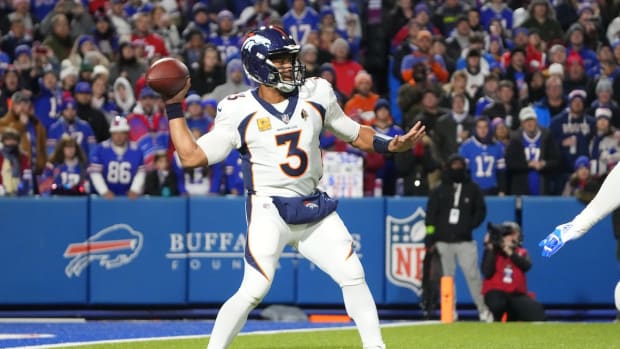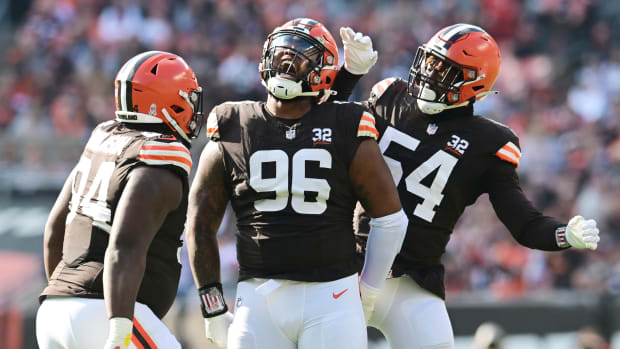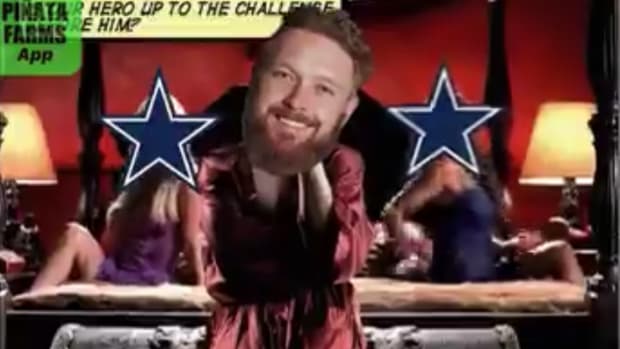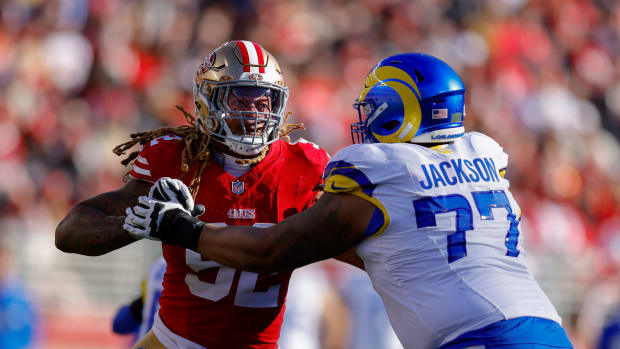Star-studded flag football league leans on NFL influences in debut
SAN JOSE — On a sunny summer evening in California, four-time Pro Bowl quarterback Michael Vick dropped back inside his own 35-yard line and scanned the field. He picked out two-time Super Bowl champion Dennis Dixon, the team’s second-string quarterback subbing in at receiver, running a route out wide to the right. Vick’s lofted pass dropped perfectly into Dixon’s bare hands as he crossed the opponent’s 30. Dixon sprinted down the sideline. Safety Kerry Rhodes, an eight-year NFL veteran, grasped hopelessly at the air as he tried to catch him. Touchdown, seven points.
Seven points? Yes, seven. Welcome to the American Flag Football League. Because Dixon’s 60-yard run was more than half the length of the 100-yard field, he scored seven points, not six. Vick then had a choice of whether to go for one, two or three extra points, according to how far back from the end zone the ball was snapped. He chose five yards, then hit recently retired running back Justin Forsett for one.
The new league played its inaugural game at Avaya Stadium, home of the San Jose Earthquakes, on Tuesday. That contest was simply a demonstration event, pitting two teams of NFL misfits against each other to showcase what pro flag football might look like.
Wearing No. 7, Vick lead the white team, and in No. 81, Terrell Owens headlined the red team. A few of the players had long careers in the NFL; many played just a handful of games before getting injured or being cut; some never got further than declaring for the draft. Max Seibald, one of Team Vick’s defensive backs, played college and professional lacrosse.
Michael Vick’s Playing Days Aren’t Over
The AFFL is seven-on-seven no-contact football. Players stay on the field for both offense and defense, and “losers walk”—meaning when your opponent scores, they take your end zone and you have to walk to the other end of the field. Kickoffs are replaced with throw-offs, and since there are no field goals, there are no uprights behind the end zones.
Players tackle without contact, but instead by ripping off one of the flags hanging down from a belt around each athlete’s waist. “There is a flag on the play,” takes on a different meaning. (Though there are still penalty flags for those times when players instinctively grab a little bit more of each other than just the trailing streamers.)
Jeff Lewis, a bond trader, decided to launch the AFFL after watching his son, Hayden, play flag football. Lewis ran three test games with high school and college players prior to Tuesday. “The same exact thing happens every time,” Lewis said afterwards. “Great athletes, tough guy football players, turn into little kids.”
Gone are the bulky pads and helmets. Vick wore a blue soft helmet over his baseball cap, similar to the headgear some rugby players wear. Most players at Tuesday’s game wore baseball caps and headbands, making them seem more like real people and less like football robots. One of the AFFL’s intentions is to turn players into personalities, or at least humanize them a little. They can tweet from the sidelines and excessive celebration is actively encouraged.
“For a lot of us who grew up playing backyard football,” said Owens after the game, “this is what we like to do.”
“I can’t stress enough how much fun it was just to be out here in this atmosphere just running around,”
Behind the smiles, a little confusion and frustration was evident early on as players got use to the rules. But as they did, the spectacle improved. Team Owens’s Nikita Whitlock, a former Giants fullback who was suspended by the NFL for 10 games last year for taking performance enhancing drugs, danced and spun through Team Vick’s line on several plays.
“I’ve been playing flag football since I was a kid,” said Team Vick’s ex-pro receiver Chad (Ochocinco) Johnson. “Defensively and offensively, it’s no different than being in the NFL.”
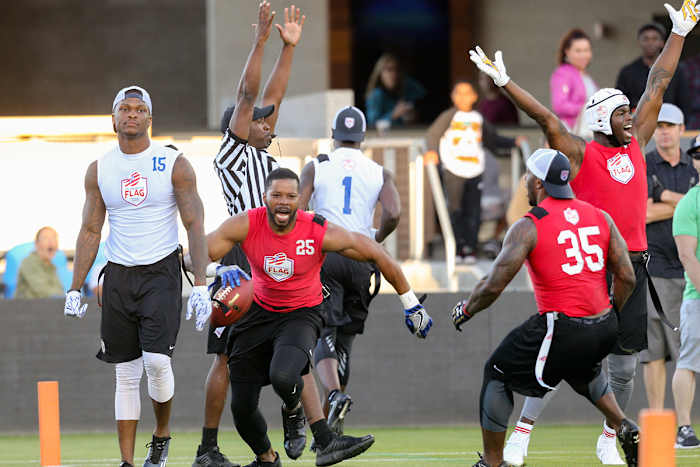
The NFL influences on the AFFL's pilot game were evident as Kerry Rhodes (25) and former Patriots RB Jonas Gray (35) celebrated a touchdown.
Courtesy of the AFFL
As Team Vick began another series at the beginning of the fourth quarter, one fan taunted the quarterback from the stands: “Vick, throw a pick.” There wasn’t much doubt about whose side he might be on, wearing Owens’s No. 81 Niners jersey and watching this game less than five miles away from Levi’s Stadium.
Vick had already obliged, throwing an interception in the second quarter, but unfortunately for Team Owens supporters, he also threw eight touchdowns on the way to a 64–41 victory.
Many of the stands at Avaya were closed off on Tuesday, and attendance at the game was low. The loudest roars came from jets landing at San Jose International Airport across the street. No one even tried to make enough noise to drown out play calls on third down.
The fans that did come to watch came because of contact football, wearing jerseys representing NFL teams and the handful of former pros on the field. Even Team Vick’s Evan Rodriguez, who won the MVP award in the flag football game on Tuesday, saw this event from an NFL perspective. “[I’m] definitely trying to get back in the NFL,” he said after the game. Rodriguez played 20 games over three years for the Bears, Bills and Buccaneers, but last year he played indoor football for the Lehigh Valley Steelhawks in Allentown, Pa. “Hopefully this wakes them up.”
Vince Young's journey north to rewrite the ending of his football career
One of the challenges for the AFFL is going to be finding a way to attract enough ex-NFL star talent to bring in football fans without becoming a rec league where former pros simply go to retire. Another problem will be surviving in the hyper-competitive U.S. sports market. Soccer, a global success story, has taken decades to reach respectability in America.
Next year’s inaugural AFFL season is planned for the summer months, May through July. But the window between the end of the NBA and NHL playoffs and the return of full contact pro and college football is short, and while MLB is only in midseason, is short. And unfortunately, that pits flag football head-to-head with another sports event that has been steadily gaining momentum in the American market: the World Cup.
































